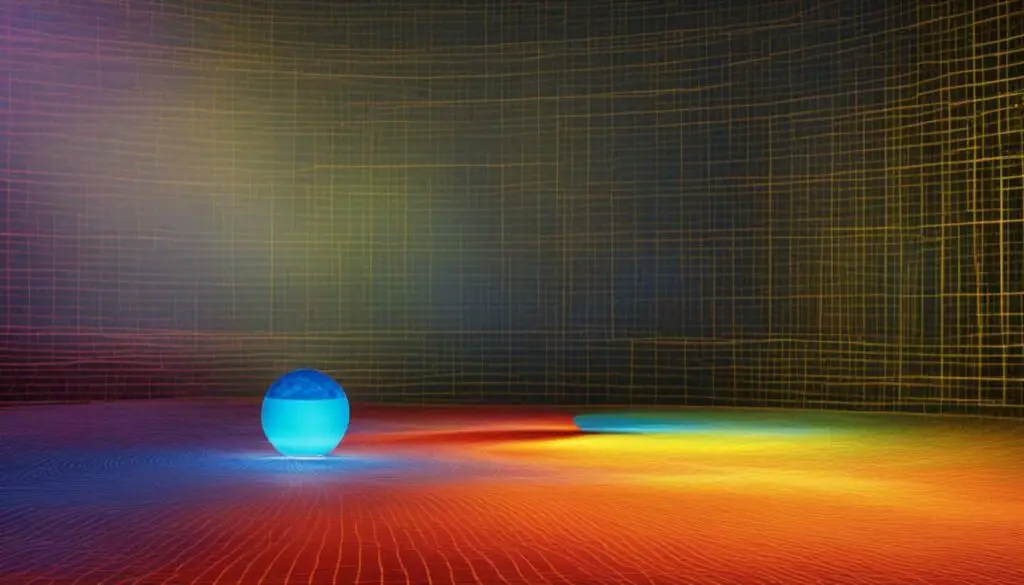Last Updated on 5 months by Francis
Have you ever wondered why infrared waves are often called heat waves? Infrared waves are a type of electromagnetic radiation that we cannot see, but we can feel their effects as heat. They play a crucial role in many aspects of our daily lives, from heating systems to thermal imaging cameras. In this section, we will explore the science behind infrared waves and their connection to heat.
Infrared waves are a part of the electromagnetic spectrum, which includes radio waves, microwaves, visible light, ultraviolet radiation, X-rays, and gamma rays. Infrared waves have longer wavelengths than visible light but shorter wavelengths than microwaves. They are generated by warm objects and can be detected by specialized equipment.
Infrared waves are often called heat waves because they are closely associated with thermal energy. When warm objects emit infrared radiation, we feel the heat that radiates from them. Similarly, when we feel heat from a fire or a warm surface, we are actually sensing the infrared waves that are being emitted.
It is important to note that not all infrared waves are heat waves. Infrared waves can also be used in communication systems, remote controls, and other technologies. However, their association with heat is what makes them so valuable in many fields.
Contents
Key Takeaways:
- Infrared waves are a type of electromagnetic radiation that are generated by warm objects.
- Infrared waves are often called heat waves because they are closely associated with thermal energy.
- Infrared waves are a part of the electromagnetic spectrum and have longer wavelengths than visible light but shorter wavelengths than microwaves.
- Infrared waves can be detected by specialized equipment and have important practical applications in various fields.
- Not all infrared waves are heat waves and can also be used in communication systems, remote controls, and other technologies.
Understanding Infrared Waves and Infrared Radiation

Infrared waves are a type of electromagnetic radiation that have wavelengths longer than those of visible light. While we can’t see infrared waves, we can feel their effects as heat. Infrared radiation is the energy that is carried by these waves.
Infrared waves are part of the electromagnetic spectrum, which includes everything from radio waves to gamma rays. They have shorter wavelengths than radio waves but longer wavelengths than visible light. One of the unique properties of infrared waves is that they can pass through some materials that other types of radiation cannot.
Infrared waves are generated by the movement of atoms and molecules. The higher the temperature of an object, the more infrared radiation it emits. This is why we feel warm when standing near a fire or a heated object.
One of the most common uses of infrared waves is in thermal imaging. Infrared cameras detect the amount of radiation emitted by an object and use it to create an image. This allows us to see temperature variations and identify objects that might be difficult to see with the naked eye.
Fun fact: The term “infrared” was coined by William Herschel in the early 19th century. Herschel discovered infrared radiation while studying the temperature differences between the colors of the spectrum.
Overall, understanding infrared waves and their relationship to infrared radiation is crucial in many fields, including medicine, industry, and astronomy. By harnessing the power of infrared waves, we can gain valuable insights into the world around us.
The Connection Between Infrared Waves and Thermal Energy
As we have established earlier, infrared waves are an essential component of the electromagnetic spectrum. These energy waves are closely related to thermal energy, which is a measure of the internal energy of an object or system.
Thermal energy is generated by the movement of atoms and molecules within a substance. As these particles move faster, they produce more thermal energy, which can be measured using various instruments.
One of the ways in which thermal energy can be measured is through the use of infrared waves. Warm objects emit infrared waves, which can be detected by specialized instruments such as infrared cameras and thermometers.
These instruments work by detecting the amount of infrared radiation emitted by an object and converting it into a temperature reading. In this way, infrared waves play a crucial role in temperature measurement and monitoring.
| Application | Function |
|---|---|
| Infrared thermometers | Measure temperature without direct contact |
| Infrared cameras | Visualize temperature variations across a surface |
Aside from their applications in temperature measurement, infrared waves also have a significant role in various heating systems. These waves enable the transfer of heat between objects through a process known as radiation, in which energy is transferred through space without the need for a medium.
For example, many household heating systems use infrared waves as a means of heating a room. These systems typically use heating elements that emit infrared radiation, which is absorbed by nearby objects, including people, walls, and furniture. As the objects absorb the radiation, they heat up, increasing the temperature of the room.
Overall, infrared waves are critical in our understanding of thermal energy and temperature measurement. They play an important role in various heating systems and are used in a range of instruments, from infrared cameras to thermometers.
Heat Transfer and Infrared Waves

One of the most significant applications of infrared waves is their role in heat transfer. Infrared waves are capable of transferring heat from one object to another, making them an integral part of various heating systems.
In many cases, the transfer of heat via infrared waves occurs through the process of radiation. Warm objects emit infrared radiation, which can be absorbed by cooler objects. This results in the transfer of heat from the warmer object to the cooler object.
A practical example of this can be seen in outdoor heating systems. Infrared heating panels are often used to warm outdoor spaces such as patios and decks. These panels emit infrared radiation, which is absorbed by nearby objects, including people. This results in a feeling of warmth, even in cool outdoor temperatures.
Infrared waves also play a crucial role in industrial heating systems. For example, infrared heaters are often used in food processing facilities to dry and cook food products. The use of infrared waves provides a more efficient heating source compared to traditional methods such as convection or conduction.
The Advantages of Infrared Heat Transfer
Compared to other forms of heat transfer, infrared waves have several unique advantages. One of the most significant advantages is that they can transfer heat without the need for a physical medium. In other words, infrared waves can transfer heat through a vacuum, making them ideal for use in outer space.
Infrared waves are also highly efficient at transferring heat. This is because they can be targeted to specific objects or areas, reducing heat loss and increasing energy efficiency. Additionally, infrared heating systems can be controlled with a high degree of precision, allowing for more accurate temperature regulation.
Overall, the role of infrared waves in heat transfer cannot be overstated. From outdoor heating systems to industrial processing, these energy waves are an essential component of many heating solutions.
The Science Behind Infrared Waves and Warm Objects

Have you ever wondered why you can feel the warmth of a fire, even when you’re not right next to it? The answer lies in the science of infrared waves.
When an object is heated, it emits infrared waves that travel through the air and can be detected by our skin. The warmer the object, the more infrared radiation it emits. This is why we can feel the warmth of the sun on our skin, even though there is no physical contact with the sun itself.
But how do these waves interact with warm objects? Infrared waves are absorbed by materials that are good conductors of heat, such as metals. This is why metal objects tend to feel hotter than non-metal objects, even if they are at the same temperature.
On the other hand, materials that are poor conductors of heat, such as wood or plastic, do not absorb as many infrared waves and therefore do not feel as warm to the touch.
Infrared waves also play a crucial role in temperature measurement. Infrared thermometers detect the amount of infrared radiation emitted by an object and use this data to determine its temperature. This technology is widely used in industries such as food processing, where accurate temperature measurement is critical to ensuring product safety.
| Material | Absorption of Infrared Waves |
|---|---|
| Metal | High |
| Plastic | Low |
| Wood | Low |
Interestingly, our bodies also emit infrared waves. In fact, infrared imaging technology can be used to take images of the human body and detect areas of inflammation or injury.
Overall, the science behind infrared waves and their interaction with warm objects is fascinating and has numerous practical applications. From heating systems to medical imaging, the study of these energy waves has revolutionized many aspects of our lives.
Practical Applications of Infrared Waves and Heat Waves

Infrared waves and heat waves have a wide range of practical applications, from heating systems to thermal imaging. They are used in numerous industries to measure temperature, detect objects, and improve safety.
Heating Systems
Infrared waves play a crucial role in heating systems, particularly in outdoor heating applications. Infrared heaters use radiation to transfer heat directly to objects and people in their path without heating the surrounding air. This method of heating is highly efficient and can save energy and money by reducing heating costs.
One example of the use of infrared waves in heating systems is in outdoor patios. Infrared heaters can be mounted overhead to provide warmth to guests while they enjoy their outdoor activities. These heating systems are also used in warehouses and industrial buildings to provide heat to large open spaces where traditional heating methods may be inefficient.
Thermal Imaging
Another practical application of infrared waves is in thermal imaging. Infrared cameras can detect infrared waves emitted by objects to create images that show variations in temperature. This technology is used in various fields, from medical imaging to building inspections.
One example of the use of thermal imaging is in the medical field. Infrared cameras can be used to detect differences in skin temperature, which can indicate areas of inflammation or infection. This technology can also be used in building inspections to identify areas of heat loss or water intrusion.
Other Applications
In addition to heating systems and thermal imaging, infrared waves are used in various other applications. For example, they are used in security systems to detect movement and in cooking appliances to monitor food temperature.
Furthermore, infrared waves are instrumental in many medical applications, such as infrared therapy. This treatment uses infrared waves to provide deep tissue heating, which can help alleviate pain and inflammation.
Infrared waves and heat waves have a wide range of practical applications, from heating systems to thermal imaging.
Interesting Facts About Infrared Waves

If you thought you knew everything about infrared waves, think again! Here are some fascinating facts that might surprise you:
- They were discovered by accident: Infrared waves were first discovered in the early 19th century by astronomer Sir William Herschel, who was measuring the temperature of different colors of light and noticed that the temperature was highest beyond the red end of the spectrum.
- They are everywhere: Infrared waves are all around us, emitted by everything from the sun to our own bodies. Even ice cubes emit a small amount of infrared radiation.
- They can help us see in the dark: Infrared radiation is used in night vision goggles to allow soldiers and law enforcement officers to see in the dark. It works by detecting the heat emitted by objects, rather than relying on visible light.
- They are used in cooking: Many modern ovens use infrared radiation to cook food faster and more evenly than traditional ovens. The infrared waves penetrate the food and cook it from the inside out, resulting in a delicious meal.
- They can be harmful: While infrared waves are generally considered safe in small doses, prolonged exposure to high levels of infrared radiation can be harmful to the eyes and skin.
- They are used in medical imaging: Infrared radiation is used in medical imaging to create thermal images of the body. This allows doctors to see areas of inflammation and identify potential health issues.
These are just a few of the many interesting facts about infrared waves. As we continue to advance in technology and scientific discovery, undoubtedly more will be uncovered!
Advancements in Infrared Technology

The study of infrared waves has led to many fascinating discoveries and technological advancements. Scientists and researchers have been continuously working to improve the detection and application of these waves, leading to new breakthroughs in several industries.
One of the most significant advancements in infrared technology is the development of thermal imaging cameras. These cameras use infrared waves to detect and visualize thermal energy, allowing users to see heat signatures and temperature changes in objects and environments. Thermal imaging is widely used in various fields, including medical diagnosis, security and surveillance, and industrial inspection.
Another exciting development in infrared technology is the use of infrared spectroscopy for chemical analysis. By measuring the absorption and transmission of infrared waves, scientists can identify and analyze the properties of different chemicals and molecules. This technique is used extensively in chemistry and pharmaceutical research, helping to improve our understanding of the molecular structure of various compounds.
Infrared waves have also become an essential tool in monitoring and controlling temperature in heating systems. Infrared heaters use these waves to emit heat directly onto objects and surfaces, providing efficient and targeted heating. This technology has become popular in both residential and commercial heating systems.
With the increasing demand for more efficient and effective tools, infrared technology has continued to evolve and improve. Scientists are constantly exploring new ways to harness the power of infrared waves to solve some of the world’s most pressing problems, from climate change to medical research.
The Importance of Infrared Waves in Everyday Life

While infrared waves may not be visible to the naked eye, they play a significant role in our daily lives, from household appliances to security systems and medical applications. Let’s explore some of the ways they impact us:
- Household Appliances: Infrared waves are used in a range of household appliances, from ovens and stoves to remote controls and alarm clocks. They enable us to control the temperature of our homes and cook food more efficiently.
- Security Systems: Infrared waves are also used in security systems to detect motion and monitor activity. Infrared cameras can capture images in low light conditions and are often used in businesses and homes to deter potential intruders.
- Medical Applications: Infrared waves have several medical applications, including detecting tumors and diagnosing skin conditions. They can also be used in therapy to promote healing and reduce pain.
As you can see, the use of infrared waves extends far beyond just heating systems and temperature measurement. Understanding their role in various industries and applications can help us appreciate their significance in our everyday lives.
“The use of infrared waves extends far beyond just heating systems and temperature measurement.”
The Limits of Infrared Waves Within the Electromagnetic Spectrum
https://www.youtube.com/watch?v=8-zO8_VoOe4
As we’ve previously discussed, infrared waves are a vital part of the electromagnetic spectrum, occupying a unique position between visible light and radio waves. However, despite their many applications in our daily lives, there are limits to the extent of their usefulness.
It’s important to note that while infrared waves are often referred to as “heat waves,” this term is not entirely accurate. Infrared waves are a type of electromagnetic radiation that can carry heat, but they are not, in themselves, heat. Their primary function is to transfer thermal energy from one object to another, making them useful in various heating systems and temperature measurement tools.
One of the key limitations of infrared waves is their inability to penetrate objects with significant thickness or density. This means that infrared thermography techniques cannot be used to detect deep-seated defects in structures or machinery. Instead, other techniques, such as x-rays or ultrasonic testing, must be employed.
Another limitation is the short range of infrared waves. While they can be useful in close proximity applications or short distances, such as within a heating system, they quickly lose intensity over longer ranges. For example, infrared waves are not suitable for communication purposes and are not used in wireless technologies like Wi-Fi or Bluetooth.
Finally, while infrared waves have proven useful in many applications, they are not a one-size-fits-all solution. For certain applications, such as medical imaging or remote sensing, other parts of the electromagnetic spectrum, such as X-rays or microwaves, may be more appropriate.
Overall, while infrared waves have many applications in our daily lives, it’s crucial to understand their limitations and their place within the electromagnetic spectrum.
Conclusion
Throughout this article, we have explored the fascinating world of infrared waves and heat waves. We have seen that these energy waves are closely tied to the concept of thermal energy, and play a crucial role in our understanding of temperature and heat transfer.
From their practical applications in heating systems, to their use in medical technologies and household appliances, it’s clear that infrared waves are an integral part of our everyday lives.
We have also uncovered some interesting facts about these waves, including their historical significance and unique properties. As technology continues to advance, we can expect to see even more exciting developments in the field of infrared technology.
Overall, it’s clear that infrared waves are a fascinating and important area of study for scientists and engineers alike. Whether we’re using them to keep our homes warm or to detect health issues, these waves are an essential part of our world.
FAQ
Why are infrared waves often called heat waves?
Infrared waves are often called heat waves because they are responsible for transmitting thermal energy. They are closely associated with heat due to their ability to detect and measure temperature.
What are infrared waves?
Infrared waves are a form of electromagnetic radiation with longer wavelengths than visible light. They exist on the electromagnetic spectrum between microwaves and visible light waves.
How do infrared waves contribute to temperature measurement?
Infrared waves can measure temperature by detecting the heat radiating from objects. They allow for non-contact temperature measurement and are commonly used in devices such as infrared thermometers.
What is the role of infrared waves in heat transfer?
Infrared waves play a significant role in heat transfer by enabling the transfer of thermal energy from warmer objects to cooler ones. They facilitate the process of conduction, convection, and radiation in various heating systems.
How are infrared waves used in thermal imaging?
Infrared waves are used in thermal imaging to capture and analyze the heat emitted by objects. Thermal cameras detect infrared radiation and convert it into a visible image, allowing for the visualization of temperature variations.
What are some practical applications of infrared waves?
Infrared waves have numerous practical applications. They are used in heating systems, industrial processes, thermal imaging cameras, security systems, medical devices, and even in cooking appliances such as infrared grills.
What are some interesting facts about infrared waves?
Some interesting facts about infrared waves include their discovery by Sir William Herschel in 1800, their historical significance in understanding heat radiation, and their ability to detect hidden objects in certain security systems.
How has infrared technology advanced over time?
Infrared technology has advanced significantly, leading to improved understanding and utilization of infrared waves. Advancements include the development of more sensitive and accurate sensors, thermal imaging devices, and sophisticated applications in various industries.
How are infrared waves important in everyday life?
Infrared waves play an important role in everyday life. They are used in household appliances like remote controls, security systems for motion detection, and medical applications such as infrared thermography for diagnosing health conditions.
Where do infrared waves stand in the electromagnetic spectrum?
Infrared waves are situated between microwaves and visible light waves on the electromagnetic spectrum. They have longer wavelengths than visible light, making them invisible to the human eye but detectable as heat.








